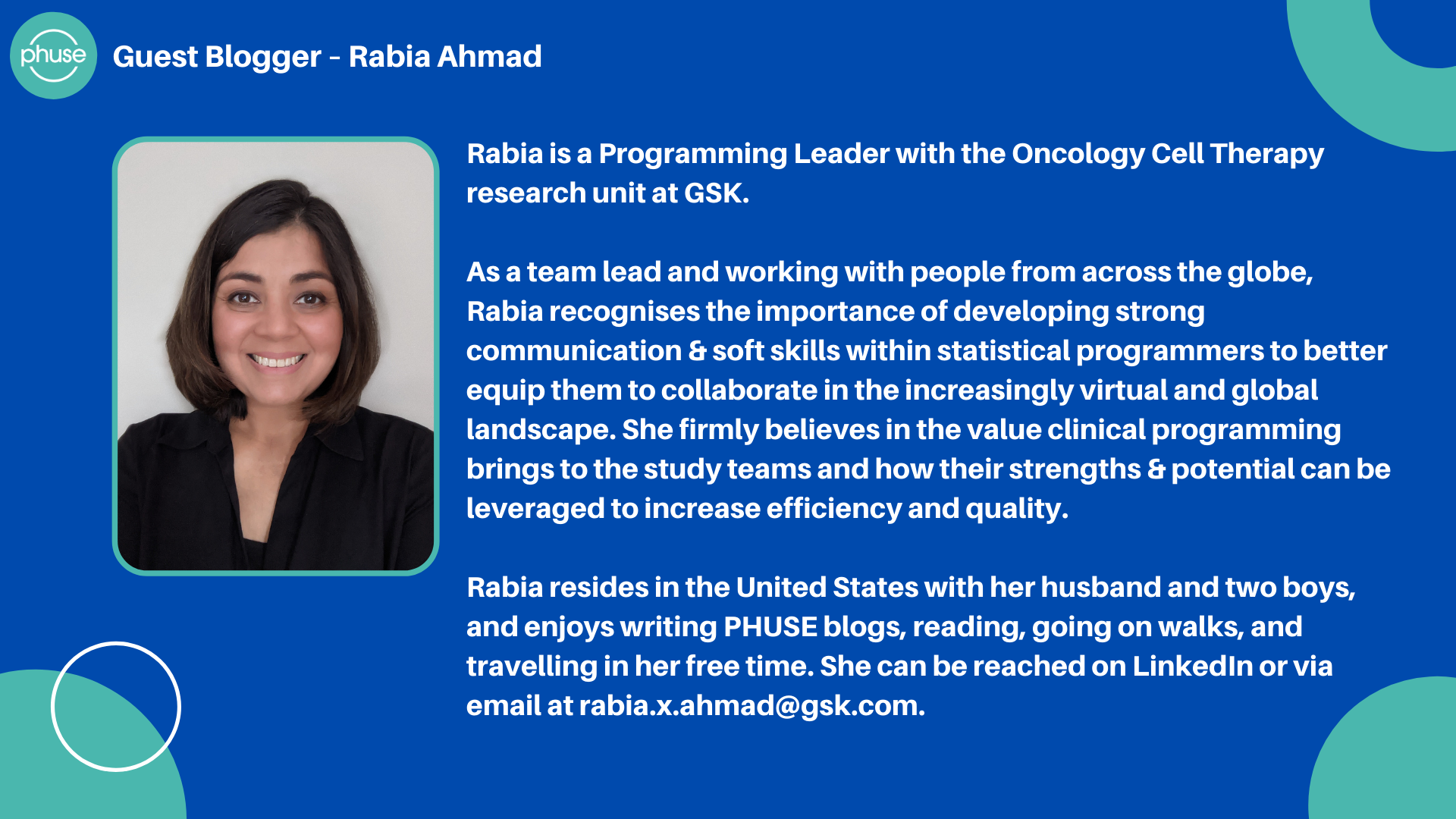Written by Rabia Ahmad, Programming Leader at GSK Please note, this blog is the opinion of the author and does not represent PHUSE nor necessarily the opinion of the authors employer.
 Graphic Made by Rabia’s son; Ahmad Imam.
Graphic Made by Rabia’s son; Ahmad Imam.
Recently, PHUSE asked me to write a separate article on each of the five best practices I had shared in my PHUSE blog, “I Say, You Say and The Art of Communication”. Given the enormity and complexity of the task, it was a tough decision to accept the challenge. However, the writer in me jumped at the opportunity; so, here’s the first in a series of five blogs on the best practices for effective communication.
I would like to clarify that the opinions voiced in my blogs reflect my own experiences, observations, readings, learnings from leadership courses and self-assessments. I do not claim to have done any research to support the validity of the content and ideas other than 1) the knowledge that these practices have never failed me and 2) any learnings from when these practices were not applied.

Principles and Practices
People often confuse the meaning of “principles” and “practices” and use the terms interchangeably. However, this is not correct. It is therefore important to clarify their meanings, as used in this blog and the four future ones.
**Principles:**These are fundamental qualities of human beings and society without which success, long-term relationships, progress or change cannot be achieved. Consider these to be natural laws or points of convergence, such as honesty, growth, respect, empathy, fairness, justice, quality, courage, dignity, excellence. Principles cannot be broken or changed and any attempt at doing so, even if it seems to succeed in the short term, is futile.
Practices: These are how human beings and society value, interpret and apply the principles to achieve their desired goals. Existing practices can be modified or made obsolete, and new ones created. Practices in most cases are situational and, if built on sound principles, can help human beings improve and succeed. For example, Good Clinical Practices (GCPs) allow the team to deliver quality and timely results, ensure data integrity and protect the privacy of the patients enrolled in the study. These practices are built on the principles of trust, integrity and quality. GCPs can be changed, but the underlining principles cannot.
Defining Self-Assessment
Reliability, honesty, trust and empathy are some of the key principles that drive the best practices for effective communication. The purpose of self-assessment is to gauge the alignment of our behaviour, feelings and actions with these principles.
Communication starts with the communicator (the “who”). The communicator’s ability to practise self-assessment becomes the foundation of their ethos, pathos and logos and helps them clearly identify the “what”, “why”, “how” and “whom”. Together, these determine the success of the communicator and the effectiveness of the communication.
Self-assessment is an “inside-out” process. It requires looking “inside” to understand and accept our strengths and weaknesses, principles and values, perceptions and mindset, and reactions to external stimuli before moving “out” to interact with others. Successful self-assessment results in a deep and thorough awareness of ourselves and of the effect of our behaviour and feelings on our actions and on others. Daniel Goleman, in his article What Makes a Leader?, identified self-assessment as the first component of emotional intelligence, an essential for successful human relationships.
When applied to communication, self-assessment allows us to pause and plan our strategy, understand the purpose and clarity of our vision, tailor our message to our audience and formulate clear and well-defined reasoning to ensure the desired outcome.
Best Practices for Self-Assessment
Targeted: Self-assessment is applicable to any situation. Hence, it is important to engage in “targeted self-assessment”; that is, the questions we ask ourselves during our moments of reflection should be fit-for-purpose.
Proactive: Self-assessment should happen before an interaction and after it is completed. The former promotes “proactive planning”; the latter supports “proactive learning”. It’s cyclical and should be a standard practice.

On the other hand, there are two habits which stop people from engaging in self-assessment.
-
Denying responsibility and accountability: This is a pretty common and very detrimental habit for any type of improvement. It is led by ego and fear; fear of critique, of failure, of incompetency, or of consequences. The reverse of this habit requires courage and self-confidence. It’s important to be aware of our strengths, but it is imperative to realise and improve our weaknesses.
-
Playing the blame game: This habit is typically the result of the previous one. People fall for it because it’s the easiest course of action and also because “owning up” or “initiating improvement” requires humility and stepping outside of our comfort zone. Honesty to ourselves and others reflects in our communication and builds relationships based on mutual trust and respect.
Conclusion
The first step towards improving effective communication skills is to have confidence in our strengths and to have the ability to identify, acknowledge and take ownership of addressing our weaknesses and prejudices. This requires time to reflect, and courage to engage in critical and honest self-assessment.
Although this blog focuses on the impact of self-assessment on communication skills, the practice forms the basis of developing/improving any skill. It’s a progressive state of mind and given its absolute importance, it should be a habit (rather than an action) practised continuously to drive and support our efforts to improve, grow and develop.
References
Stephen R. Covey. The 7 Habits of Highly Effective People. Franklin Covey. Maryam Kouchaki & Isaac H. Smith. Building an Ethical Career. Harvard Business Review Magazine. January–February 2020. Jennifer Porter. Why You Should Make Time For Self-Reflection (Even If You Hate Doing It). Harvard Business Review. March 21, 2017. Daniel Goleman. What Makes a Leader? Harvard Business Review Magazine. January 2004.
About the Author

